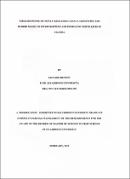| dc.description.abstract | This study determined the effect of intercropping the newly developed cassava (Manihot
esculenta Crantz) genotypes with hybrid maize (Longe 6H) and NPK fertilizer appljcation on
the growth and yield of the component crops. The specific objectives were to determine the
effect of maize planting density in the cassava/maize inter crop on the growth and yield of the
component crops, and to determine the effect of NPK fertilizer on the growth and yield of the
newly released cassava genotypes.
In experiment one, two newly released cassava genotypes NAROCASS 1 and NASE 14
inter cropped with Longe 6H maize were evaluated in different combinations including sole
maize (SM), sole cassava (SC), one row of maize and cassava ( 1C:1 M), and two rows of
maize and cassava (1C:2M). Inter cropping significantly influenced maize plant heights; cob
length, the number of rows per cob and the maize grain weight when compared with sole
cropping. The cob length and the number of rows per cob decreased in the order
SM> 1C:1 M> l C:2M indicating that as the plant population density increases, the cob length
and the number of rows per cob gradually decrease. In both NAROCASS I /Maize and NASE
14 /Maize intercrops, maize grain yield under the low plant density (1C:1 M) was comparable
to sole cropping than those at the higher plant density (1 C:2M). Thus indicating that
increasing maize plant population density (I C:2M) significantly reduced grain yields
compared to grain yields at low plant population density (lC:lM). Similarly, cassava root
yield decrease in the same order (SM> 1C:1M>1 C:2M) indicating that increased in population
gradually reduced root yield. The land equivalent ratio (LER) values for intercrops were
greater than one, indicating yield advantage of intercropping over sole cropping.
In experiment two, the effects of NPK fertilizer on the growth and yield of the newly released
cassava genotypes were assessed at three levels of 200, 400 and 600 kg/ha. Fertilizer
application up to 400 kg/ha significantly (P<0.05) influenced the cassava root length, fresh | en_US |

